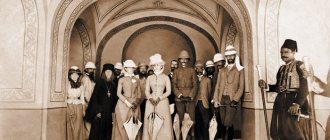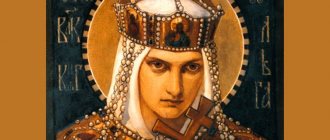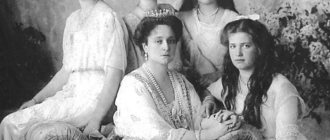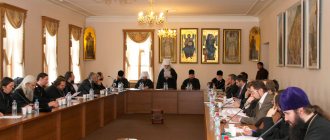Rus
The phrase “Grand Duke” has been found in narrative Russian sources since the 11th century, but at this stage it is of a laudatory, personified nature and has no signs of a formalized title. The appearance of the title “Grand Duke” dates back to the second half of the 12th century and is associated with the political realities of the collapse of the Old Russian state, the growing ambitions of individual Rurik families and the need to formalize a multi-stage title[1]. Attempts to establish the grand ducal title took place in parallel in several lands of Rus' at once - Kyiv, Chernigov, Galicia-Volyn, Smolensk, Vladimir-Suzdal and, probably, Novgorod [2]. This process, however, was dramatically changed by the Mongol invasion. In Southwestern Rus' it died out due to large-scale destruction and the subsequent subordination of the Russian principalities to Lithuania and Poland. In North-Eastern Rus', circumstances, on the contrary, contributed to the establishment of the grand-ducal title, which appeared here at least during the reign of Vsevolod the Big Nest[3].
The Grand Duke in Moscow, engraving by Abraham de Bruyn.
The institution of grand-princely power was convenient for the Mongol khans, who presented the prince they had chosen and recognized their supremacy with a label to collect tribute from other princes. The Grand Duke could, in turn, rely on the military power of the Mongols to ensure the indisputability of his seniority. From the beginning of the 14th century, the Vladimir great princes added the prefix “All Rus'” to their title, although they had practically no real power prerogatives outside of North-Eastern Rus' and Novgorod (which recognized the suzerainty of the Vladimir princes). From the middle of the 14th century, great principalities also appeared in North-Eastern Rus': Suzdal-Nizhny Novgorod, Tver and Ryazan. For a short period in the 14th-15th centuries, the Pronsky (after separation from Ryazan) and Yaroslavl princes were also titled “great”. There are different opinions among scientists about who initiated the emergence of new great reigns. According to the point of view of some, the same Horde contributed to the proliferation of the grand ducal title for the sake of devaluing the power of the overly strengthened grand princes of Vladimir. Others, on the contrary, believe that internal processes played a decisive role.
Vladimir, who continued to remain nominally the oldest table, became the property of the Moscow princes. From this time on, the Moscow princes were also titled “great.” Beginning with the reign of Dmitry Donskoy, the Moscow princes called themselves not only the Grand Dukes of Vladimir, but also those of Moscow. The Grand Dukes of Tver gained complete independence until the annexation of the Tver principality to the Moscow principality (1485).
After the unification of the Russian lands around Moscow and Lithuania, by the beginning of the 16th century, the title “Grand Duke” remained only with the rulers of these states - the “ Grand Dukes of Vladimir, Moscow and All Russia”
" and "
Grand Dukes of Lithuania and Russia
" [4]. The remaining great princes left the historical stage. In 1547, the Grand Duke of Moscow Ivan IV officially adopted the title “tsar”, but retained the previous title in relation to the former grand-ducal thrones he occupied.
Russian empire
See also: List of Grand Dukes of the Russian Empire and List of Grand Duchesses and Princesses of the Russian Empire
| This section is missing references to information sources. Information must be verifiable, otherwise it may be questioned and deleted. You may edit this article to include links to authoritative sources. This mark was set on November 7, 2021 . |
Since 1721, by the decision of Peter I (formally - at the proposal of the Senate, which Peter approved after several days of deliberation), Russian monarchs began to be called “emperors”, but at the same time the title “Grand Duke” continued to be used in the full title of the monarch when listing the lands under his authority : “...the king of Kazan, Astrakhan and Siberia, the Grand Duke of Smolensk, Tver, Vyatka and other lands.”
In the era of absolutism, the titles “Grand Duke” and “Grand Duchess (Grand Duchess)” began to be assigned to the children (male and female, respectively) of the reigning monarch, which was officially enshrined in the “Institution on the Imperial Family” of Paul I of April 5, 1797 (for in general, all legitimate descendants in the direct male line). The title of Grand Duke gave the holder the formal right to be in line for the throne of the Russian Empire. The Grand Duke, by decision of the emperor, could be deprived of his title if the circumstances of his birth or life conflicted with the articles of the “Establishment” defining the requirements for persons suitable to occupy the throne. Thus, the title began to roughly correspond to the European title "prince of the blood", although the correspondence is incomplete. The fundamental differences between the prince of the blood and the grand duke were as follows:
- A bastard could also receive the status of prince of the blood, provided that he was legitimized by royal decree. The bastards of the Russian imperial family, even being legitimized, could not receive the title of Grand Duke under any circumstances [ source not specified 1715 days
]. In particular, the children of Emperor Alexander II from his second wife Ekaterina Dolgorukova, born before marriage, were called not great, but only the most serene princes of Yuryevsky, despite the fact that the marriage between their parents made it possible to legitimize them.
- The status of prince of the blood could only be obtained through the direct male line (from father to son), while the grand duke/duchess could descend from both female and male ruling persons, and be both sons and daughters.
- A prince of the blood who received this status legally (born in a legal marriage from a direct legitimate descendant of Hugo Capet, or legitimized before receiving the status), unlike the Grand Duke, could not be deprived of this status under any circumstances.
In the Russian Empire, grand dukes and princesses were officially addressed as “Your Imperial Highness.”
According to the institution on the Imperial family dated July 2, 1886, issued by Alexander III in order to limit the number of persons bearing such a title, only children and grandchildren (children of sons) of the emperor could bear it. Great-grandchildren and more distant descendants received the title Prince of the Imperial Blood.
“The title of Grand Duke, Grand Duchess and Imperial Highnesses belongs to the sons, daughters, brothers, sisters, and in the male generation, to all the grandchildren of the emperor...”[5].
Parisian childhood
Here Princess Elena Pavlovna had everything she needed for future Russian princesses. She was a typical semi-finished product for the production of the final product in the form of a European princess and a candidate for someone's daughter-in-law. Her maiden name was Charlotte Maria Württemberg, she was the granddaughter of King Frederick I, having been born in Stuttgart. It would seem a standard and uninteresting biography of another German girl “from a good family.”
But in the destinies of extraordinary people there are often extremely interesting facts of childhood and adolescence, which then affect the events of adult life. There are certainly such facts in the biography of Grand Duchess Elena Pavlovna.
A happy break from stereotypes is associated with the girl’s father, Prince Paul Karl Friedrich August. He simply fled from his home with his family to Paris, unable to withstand the constant quarrels in the palace with his older brother, the future King William I.
Charlotte Maria fell out of the assembly line of preparing German princesses for European thrones. This was the most serious test for the little girl. She had to study in a Parisian boarding school with the daughters of the new rich bourgeois families, who treated her with all the passion of childish hatred. Solving problems, dealing with difficulties and self-affirmation: the future Grand Duchess Elena Pavlovna had to learn all this at the age of 12.
Prince Paul, the father of young Charlotte Mary, was a multi-faceted, interesting man who led an active social life with an intellectual emphasis. He often took his daughters to the famous Parisian salon, owned by the biologist Cuvier, with remarkable people of that time as guests. Andre Ampère, Prosper Mérimée, Alexander Humboldt, Eugene Delacroix: scientists, artists, writers and humanists ultimately influenced the formation of the young girl’s personality. The future famous Thursdays of Grand Duchess Elena Pavlovna Romanova in the Mikhailovsky Palace in St. Petersburg were organized in the image of this particular Parisian salon.
Transylvania
Sigismund Batory (ruled Transylvania in 1581-1599), George Rakoczi II (ruled in 1648-1660) and the Hungarian king Gabriel Bethlen (ruled Transylvania in 1613-1629) called themselves Grand Dukes of Transylvania. The Austrian Empress Maria Theresa in 1765 restored Transylvania, which was part of the empire at that time, to the status of a grand duchy. After this, the title of Grand Dukes of Transylvania became part of the full title of the Austrian emperors.
The Age of Mercy: Blood, War and Prejudice
The main issue in the field of health care was connected with the concept of mercy, which was also new for Russia at that time. Grand Duchess Elena Pavlovna organized the Holy Cross community of sisters of mercy. Dressing stations and mobile hospitals in its composition were an important, but not the most difficult component of the work.
The main obstacle was the dense public prejudice against the involvement of Russian women in helping the wounded and sick. The main address of the princess's appeal with calls for help was women without family responsibilities (there were many of them). To overcome public resistance, sister of mercy Princess Elena Pavlovna visited hospitals every day and bandaged bleeding and purulent wounds in front of everyone.
After all, it’s only in the movies that sisters of mercy walk among the wounded in smart snow-white aprons and starched scarves. A hospital with wounded people is always blood, pus, a terrible smell and suffering. In addition to dressings, it is also necessary to remove the bedpan from under the bedridden patient, who is not at all a quiet angel in upbringing and behavior.
The work was extremely difficult in every sense, so Princess Elena Pavlovna considered the strength of the religious faith of the sisters of mercy to be the most reliable way to cope with difficulties. The mercy here was real.
On a significant day, November 5, 1854, acting as a sister of mercy, Princess Elena Pavlovna presented a cross with St. Andrew's ribbon to each sister from the first Holy Cross issue. The next day, all thirty-five graduates left for Sevastopol to visit Nikolai Ivanovich Pirogov, the great Russian surgeon and another faithful associate of the princess. In total, about two hundred nurses of the new generation worked under the patronage of Nikolai Ivanovich. This was the beginning of a new, important stage in the development of public health not only in Russia.
The principles of organizing work in emergency conditions were adopted by the modern International Red Cross. Its founder, Henri Dunant, wrote at one time that the Red Cross owes its gratitude to the Crimean military experience of Her Highness Grand Duchess Elena Pavlovna...
Notes
- Filyushkin A.I.
Titles of Russian sovereigns. - M.; St. Petersburg: Alliance-Arkheo, 2006. - pp. 29-30. - Filyushkin A.I.
Titles of Russian sovereigns. - M.; St. Petersburg: Alliance-Arkheo, 2006. - pp. 38-40. - Filyushkin A.I.
Titles of Russian sovereigns. - M.; St. Petersburg: Alliance-Arkheo, 2006. - P. 37. - Filyushkin A.I.
Titles of Russian sovereigns. - M.; St. Petersburg: Alliance-Arkheo, 2006. - P. 48. - Complete collection of laws of the Russian Empire. - T. XXIV, 1830. - Doc. No. 17906; v. 6. - St. Petersburg, 1888.
Russian reforms from the Mikhailovsky Palace
For more than twenty years, the famous “morganatic” Thursdays were held with a discussion of problems and issues of culture, politics, literature, etc. There was nothing like this in Russian history of the 19th century. In addition to the wide, varied agenda of discussions, their quality and depth were noted. The best minds of society were invited to the Mikhailovsky Palace, regardless of their status, rank and social status. This feature was of extremely high value, since the princess’s regular guests were the sovereign and empress and other persons from the Romanov royal family.
Thus, Alexander II had a unique opportunity to communicate with individuals whose views were alien to him, and who would never have been able to obtain his audience outside the walls of the Mikhailovsky Castle. And advanced people had the opportunity to convey their ideas directly to the royal ears, which they could not have done without the tact and communication talent of Grand Duchess Elena Pavlovna. Few people understood how she managed to form groups of guests in such a way that the sovereign did not get tired, and the guests were comfortable, and the atmosphere was relaxed.
The princess believed that a narrow circle of friends only brings harm, in which the horizon narrows, and instead of a strong will, stubbornness is formed. This heart asks for convenient and comfortable communication with friends. But the mind does not need to be pampered; it needs contradictions, new ideas and knowledge of everything that is happening outside the walls of one’s home.
The famous Thursdays of Princess Elena Pavlovna were for the progressive minds of Russia in the mid-19th century a place that would now be called a social platform. Well, the princess herself performed the role of a content manager of the highest level. All the great reforms of that time began with discussions there, in the Mikhailovsky Palace. Abolition of serfdom including.
Literature
- Grand Duke / Kuchkin V. A. // Grand Duke - Ascending node of the orbit. - M.: Great Russian Encyclopedia, 2006. - P. 5. - (Big Russian Encyclopedia: [in 35 volumes] / chief editor Yu. S. Osipov; 2004-2017, vol. 5). — ISBN 5-85270-334-6.
- Grand Duke
- article from the Great Soviet Encyclopedia. - Grand Duke // Big legal dictionary
- Exemplary A.V.
Grand Duke // Encyclopedic Dictionary of Brockhaus and Efron: in 86 volumes (82 volumes and 4 additional). - St. Petersburg, 1890-1907. - Ekzemplyarsky A.V.
Great and appanage princes of northern Russia in the Tatar period from 1238 to 1505: biographical essays on primary sources and the most important manuals: T. 1-2. - St. Petersburg, 1889-1891. — 2 t. - Grand Duchess // Encyclopedic Dictionary of Brockhaus and Efron: in 86 volumes (82 volumes and 4 additional). - St. Petersburg, 1890-1907.
- Grand Duchess // Encyclopedic Dictionary of Brockhaus and Efron: in 86 volumes (82 volumes and 4 additional). - St. Petersburg, 1890-1907.
- L. V. Belovinsky.
Grand Duke // Illustrated encyclopedic historical and everyday dictionary of the Russian people. XVIII - early XIX centuries. / ed. N. Eremina. - M.: Eksmo, 2007. - P. 79. - 784 p.: - ill. With. — 5000 copies. — ISBN 978-5-699-24458-4.
| Dictionaries and encyclopedias |
|
| Regulatory control |
|
And now public health
The Grand Duchess was an excellent, as they would say now, top manager. She managed to transform an entire industry, which is traditionally the most difficult and thankless in the social sphere of activity - healthcare, including child health.
In memory of her deceased daughters, she founded and opened orphanages near Moscow in Pavlovsk. The Maximilianovskaya polyclinic was the first in Russia to accept patients regardless of class and gender. Elena Pavlovna brought administrative order there, additionally creating an inpatient department. Subsequently, this “new generation” hospital was constantly in the princess’s attention; it began to be part of the informal association “Department of Grand Duchess Elena Pavlovna.” It also included the Elizabeth Children's Hospital and the St. Helena School, in which she was the main trustee.
The St. Petersburg Medical Academy of Postgraduate Education (Imperial Clinical Institute of Grand Duchess Elena Pavlovna) owes its existence to the princess, who, together with her close associate Professor E. E. Eichwald, invested a lot of effort in creating a new type of training clinic. For the healthcare system of that time, this was a truly revolutionary form of training and advanced training for doctors.
Charles Initiative and the abolition of serfdom
Elena Pavlovna was a very wealthy woman. She owned many villages in different Russian provinces. One of the pearls in her possessions was the Karlovka estate, which later became famous, located near Poltava. The famous “Karlovskaya Initiative” is connected with him.
The fact is that Elena Pavlovna’s participation in reform projects has always been as resourceful as possible. She sold diamonds for the conservatory, for the community of sisters of mercy, gave away an entire wing of the palace for warehouses, and even financed nursing studies.
Well, when the question of the abolition of serfdom began to be discussed in the most serious way, Elena Pavlovna completely stopped trivializing. In an effort to set an example for the Russian nobility, she freed about fifteen thousand peasants in her Karlovka in 1856.
As is usual with responsible people, this was not just liberation, but a carefully developed project with a step-by-step plan for the personal liberation of each peasant with the provision of land for a ransom. After agreement with Sovereign Alexander II, Elena Pavlovna turned to the landowners of Poltava and neighboring provinces with a request for assistance in freeing the serfs within the framework of general rules and justifications.
The analytical note compiled and comments on the progress of this most difficult reform were transferred to Grand Duke Konstantin Nikolaevich for further use of the experience in Karlovka as a successful example of reform.
Many called Elena Pavlovna the first and therefore the main force behind the abolition of serfdom in Russia. The main developer and ideologist of the reform, N.A. Milyutin, was the princess’s closest ally, and the Milyutin working group for planning and implementing the reform simply lived in her palace on Kamenny Island during the entire implementation of the plan.
For her dedication to the liberation of the peasants, Alexander II awarded the princess the gold medal “Reformer.”











